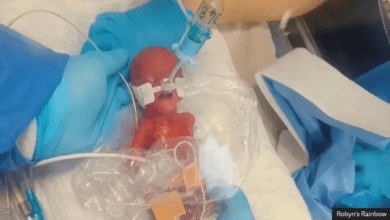CDC report shows abortion pill is being prescribed past FDA limits

The abortion pill is likely to be prescribed beyond the approved US Food and Drug Administration (FDA) gestational limit of 70 days/10 weeks, which may result in failed abortions, according to the most recent abortion surveillance published by the Centers for Disease Control and Prevention. (CDC). This seems to confirm that nefarious actors within the abortion industry are openly violating FDA-approved limits for chemical abortion pill regimens by prescribing drugs that cause abortions in the second trimester of pregnancy.
FDA Safety Requirements
In 2011, following the deaths of several women, the FDA implemented a Risk Evaluation and Mitigation Strategy (REMS) for the abortion pill, mifepristone. At that time, the drug was only approved for use up to 7 weeks of pregnancy in a regimen with the drug misoprostol.
Then, in 2016, the Obama administration weakened REMS by Removing requirements that girls or teenage girls take the first medication in front of a clinician, in person, at the location of a certified prescriber. The FDA also removed a requirement that the manufacturer report the drug nonfatal adverse events (complications), and the permitted use of the drug was extended for use in pre-born children up to 10 weeks (70 days) of pregnancy.
While the 10-week limit remains in effect to this day, the Biden Administration has expanded the use of the drug regimen by permanently allowing the drug to be shipped through the mail and more recently through REMS. announcing that it would allow retail pharmacies to dispense the drug, which they have begun to do, according to the generic manufacturer, GenBioPro.
The FDA leaves the policing of safety regulations in the hands of drug manufacturers, who benefit from not decertifying all bad actors.
Total Abortion Reported to CDC
The most recent CDC report, dated November 24, 2023, documented a total of 625,978 abortions reported to the CDC from 48 reporting areas in 2021. More recent data published October 2023 by #WeCount it is estimated that 1,072,240 preborn babies were killed by abortion between June 2022 and June 2023. This includes 88,600 produced by virtual-only abortion pill dispensaries.
“Increases in chemical abortions play a major role in the increase in abortions,” wrote Dr. Michael New, an assistant professor at the Catholic University of America and a senior associate scholar at the Charlotte Lozier Institute.
There is no federal mandate to report all abortions.
“[F]ederal abortion reporting standards remain weak, and there are serious concerns about the reliability of CDC abortion data. The CDC did not report 2021 abortion data from California, Maryland, New Hampshire, and New Jersey. In fact, the CDC has not reported any data from California since 1997 and has not reported data from Maryland or New Hampshire since 2006. Furthermore, other states have failed to report data about late-term abortions or the demographics of women who have abortions. Others fail to provide specific statistics about chemical abortions or surgical abortions,” wrote Dr. New.
General Abortion Pill Numbers
In 2021, the CDC recorded there were a total of 565,312 “medical” abortions, of which 299,449 were recorded at or less than nine weeks’ gestation and 17,155 were recorded at more than 9 weeks’ gestation.
In 2021, the CDC recorded abortions by type of procedure from 46 reporting areas as follows:
- 53.0% of abortions are early [abortion pill] abortion medication (a nonsurgical abortion at ≤9 weeks gestation),
- 37.6% were surgical abortions at ≤13 weeks of pregnancy,
- 6.4% were surgical abortions at >13 weeks’ gestation, and
- 3.0% is [abortion pill] abortion medication at >9 weeks gestation;
- other procedures, including intrauterine instillation and hysterectomy/hysterotomy, are rare (<0.1%)
“Early medication abortion is defined as the administration of drugs (usually mifepristone followed by misoprostol) to induce abortion at ≤9 completed weeks of gestation, consistent with US Food and Drug Administration (FDA) labeling for on mifepristone implemented in 2016,” the CDC wrote.
“The CDC category of ≤9 weeks gestation includes abortions up to 9 weeks and 6 days. Medications (usually serial prostaglandins, sometimes given after mifepristone) may also be used to induce abortion at >9 weeks’ gestation,” the CDC explains.
Mass Abortion Exceeds FDA Limits
The Food and Drug Administration (FDA) has only approved the abortion pill mifepristone to be safely dispensed for 10 weeks, or 70 days. At later ages of pregnancy, the failure rate increases, often dramatically, which can result in greater complications for the woman.
In addition to prescribing drugs in the past 70 days, a series titled “Bad Actors” published by Live Action News documented that the abortion industry instructs women to remove off-label drugs, has failed to properly date the pregnancy or remove the dangerous ectopic. pregnancy before prescribing drugs, spends little or no time on follow-up, intends to hide complications related to the abortion pill, and much more.
However, according to the CDC’s most recent report, chemical abortion pills “accounted for 70.6% of abortions at ≤6 weeks gestation, 61.6% of abortions at 7-9 weeks gestation, 20.6% of abortions at 10–13 weeks’ gestation, 1.3%–3.1% of abortions at 14–20 weeks’ gestation, and 12.3% of abortions at ≥21 weeks’ gestation.”
The CDC recorded a total of 470,157 abortions were reported by both type of procedure and pregnancy. Of those, 266,454 were categorized as “medication” abortions:
- 253,278: at or below 9 weeks pregnant.
- 12,231: 10-13 weeks
- 158: 14-15 weeks
- 122: 16-17 weeks
- 207: 18-20 weeks
- 458: at or above 21 weeks.
This means that abortions recorded by the CDC that were performed with mifepristone beyond the FDA-approved limit of 10 weeks, almost 1,000 are reported at gestational ages more than 13 weeks. Because the CDC does not divide the 10-13 week category, we have no way of knowing whether all or some of the 12,000 chemical abortions recorded there exceeded the approved 10-week limit.
The Abortion Pill is on the rise
According to CDC data in 2021, the percentage of chemical abortions increased by almost five percent (5%) from 53.4% in 2020 (291,890) to 56.0% in 2021 (565,312).
“As a matter of comparison, chemical abortions were only 31.6% of the total in 2016,” wrote Dr. Michael New.
Just a review of 37 reporting areas that provided continuous data and included medication abortion in their 2012-2021 reporting form, the CDC found that “use of early medication abortion increased 3% from 2020 to 2021 (from 50.6 % to 52.3% of abortions) and 137% from 2012 to 2021. 2021 (from 22.1% to 52.3% of abortions).”
“Public policy plays an important role in the incidence of abortion. The Biden Administration FDA continued [its] It is policy during the COVID period to allow women to obtain chemical abortion drugs without an in-person medical exam. This made abortion policy more permissive and likely contributed to the increase in abortion,” Dr. New wrote.
Abortion Pill Use Has Reached 6 Million Since 2000 Approval
The abortion pill was first approved by the FDA in 2000, and while CDC data is limited to states that require any abortion reporting, under REMS, the manufacturers of the abortion pill mifepristone (Danco and GenBioPro) are it is necessary report total sales of abortion pills to the FDA.
That data, provided to the FDA through the end of December 2022, showed that, since 2000, the estimated number of women who used the abortion pill mifepristone in the US for “medical termination of pregnancy” reached now at 5.9 million.
In addition to the increase in babies targeted by chemical abortions, the FDA has reported 32 deaths “related to mifepristone” since it was approved in 2000. “The FDA has received reports of serious adverse events event in patients who took mifepristone. As of December 31, 2022, there have been 32 reports of deaths in patients associated with mifepristone since the product was approved in September 2000, including two cases of ectopic pregnancy (a pregnancy outside of the womb, such as in the fallopian tubes) resulting in death; and some fatal cases of severe systemic infection (also called sepsis),” according to updated figures published on the FDA website on September 1, 2023. “Adverse events cannot be definitively attributed to mifepristone due to concomitant use of other drugs, other medical or surgical treatments, coexisting medical conditions, and information gap about the patient’s health status and the patient’s clinical management,” the FDA also said.






